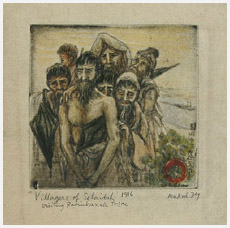MUKUL
DEY
|
| |
|
| |

23/07/1895 - 1989

|
| |
|
| |
|
|
|
 |
Artist Profile |
BEGINNINGS
He was born at Sridharkhola, Dhaka. His grandfather,
Mahim Chandra Dey, was a leading Pleader of his time
at Dhubri, Mymensingh. His father, Kula Chandra Dey,
was a poet and was in the service of the Govt. of Bengal.
1907 When he was eleven years old, he came to Calcutta
from Ghatal. In Calcutta his father took him to Rabindranath
Tagore, at his house at Jorasanko. He also got the opportunity
to meet Abaindranath Tagore and Gaganendranath Tagore
in Jorasanko, both brothres criticised and corrected
his sketches. From 1911 his paintings began to find
place in the monthly magazines published in Calcutta,
such as `Prabashi`, `Modern Review`, `Bharatvarsa` and
`Bharati`. Mr. W.W. Pearson inspired him to work with
dry point, by giving him some copper plates to scratch
with a steel pointed needle and used to send those plates
to London to be printed as it was not possible to print
them in India. 1916 Accompanied Rabindranath Tagore
to Japan and USA. 1916 In Japan.
|
| |
EDUCATION
- 1900 He began his school lessons at the Hamilton
High School, Tamluk, Midnapore.
- 1905-12 Brahmacharya Ashram, Santiniketan.
- 1912-15 Art Education from Abanindranath Tagore,
Indian Society of Oriental Art, Calcutta.
- 1916 Mrs. Bertha E. Jaques first taught him the
art of printing from copper plates in her own studio.
Also under Mr. J. Blanding Sloan, he had a course
of training in etching, Chicago.
- 1920 Studied at the Slade School of Art, under Prof.
Henry Tonks and Prof. W.W. Russell.
- 1920-22 Joined Royal College of Art with a scholarship,
where he took up the School of Painting as his subject,
but he continued to learn etching under Sir Frank
Short, and he was the first Indian to receive the
Diploma in Mural Painting, South Kensington, London.
EXHIBITIONS
- 1913-14 The Indian Society of Oriental Art sent
his paintings to Paris, London and other cities of
Europe for exhb. along with few other students of
Abanindranath Tagore.
- 1916 Arranged joint exhb. at Okakura Kakuzo`s Art
School, named Nippon Bijitsuin, Tokyo.
- 1916 Organised an exhb. of Modern Bengal School
of Paintings, Paul Elde`s Gallery, San Francisco.
- 1918 Organised an exhb. showing the different schools
of Indian Paintings, Nagpur.
- 1922,23 His paintings were accepted for exhb., Royal
Academy, London.
- 1924 One man show of his original works and copies
of frescos at Ajanta and Bagh, Sir Alfred Hamilton-Grant`s
House, Onslow Square, London.
- 1924 He received a commission to decorate a portion
of the Indian Pavilion, Wembley Exhb., London.
- 1924 Exhb. at Walker`s Art Gallery, Liverpool.
- 1926 Exhb. at Philharmonic Hall, Berlin, Germany.
- 1927 Held an exhb, of his drawings and drypoints
in his own studio near Knightsbridge, London.
- 1928 One-man show of his etc
COLLECTION
- Academy of Fine Arts, Kolkata.
- Indian Museum, Kolkata.
- National Gallery of Modern Art, New Delhi.
- Victoria and Albert Museum, London.
- Albert Roullier`s Gallery, Chicago.
- Delhi Art Gallery, New Delhi.
AWARDS
- 1922 Received scholarships and won prizes in tempera
painting and dry point engraving, Royal College, London.
- 1927 Received Their Majesties` Royal Command and
forwarded his paintings and etchings for Their Majesties`
inspection.
- 1944 Founder Member, Kalika Art Gallery, Santiniketan.
- 1936 Received Their Majesties` King George V and
Queen Mary`s Jubilee Medal.
- 1937 Received Their Majesties` Coronation Medal.
- 1953-54 Fullbright Scholar to USA.
- 1984 `Abindra Puraskar` from the Government of West
Bengal.
- 1987 Honorary Doctorate conferred on him by Rabindra
Bharati University, Calcutta.
STYLE
Mukul Dey was the `first Indian etcher` and his astonishing
achievement was in the medium `both by way of landscape
genre and portraits`. And his forte was drypoint - directly
working the sharp - pointed needle on the hard, burnished
metal plate, in deep and shallow flow of lines, in literally
thousand cross-hatches. And with the needle he had as
much effortless facility as he had with chalk, charcoal
or conte on paper. A pioneer in the art and craft of
intaglio printmaking, he played an important role in
popularising the art of printmaking among the Indian
artists. He was perhaps the first Indian to take up
printmaking as a highly individuated means of artistic
expression, instead of as a technique of reproduction.
Also he had become famous all over India for his portraits
of the celebrities of his time.
TEACHING EXPERIENCE
1913-14 Art Teacher, Kala Bhavan, Santiniketan. 1917
Taught at Vichitra Art School, Jorasanko, Calcutta.
1928-43 First Indian Principal of the Government School
of Art and Craft, Calcutta. Throughout his active career
he was on the Visiting Faculties in numerous universities
and institutions in the USA, Europe, Japan and in India,
lecturing on different aspects of Indian Art and Civilization.

back |
| |
|
|



